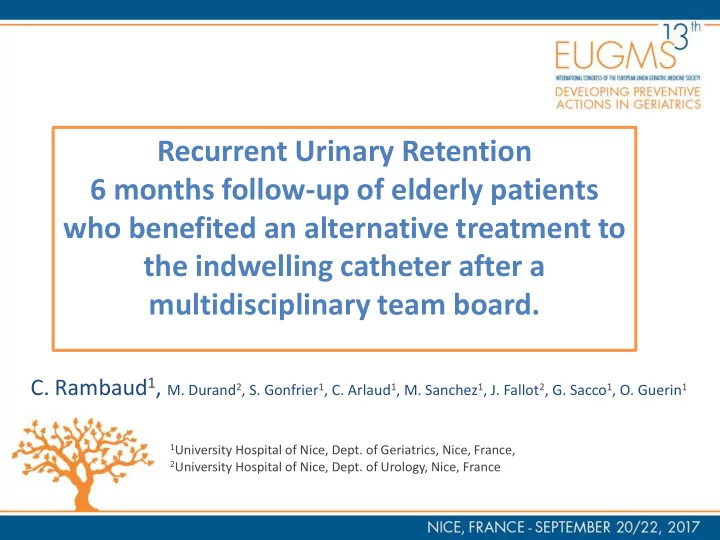

Recurrent Urinary Retention 6 months follow-up of elderly patients who benefited an alternative treatment to the indwelling catheter after a multidisciplinary team board. C. Rambaud 1 , M. Durand 2 , S. Gonfrier 1 , C. Arlaud 1 , M. Sanchez 1 , J. Fallot 2 , G. Sacco 1 , O. Guerin 1 1 University Hospital of Nice, Dept. of Geriatrics, Nice, France, 2 University Hospital of Nice, Dept. of Urology, Nice, France
CONFLICT OF INTEREST DISCLOSURE I have no potential conflict of interest to report
INTRODUCTION • The indwelling urinary catheter (IUC) is over used on the elderly with – a risk of complications such as infections, – impaired quality of life – a loss of autonomy • Alternative treatments (AT) exist but underused – No recommendation available – Difficulties of decision making
Geriatrician Urologist Do Not undertreat Do Not overtreat Appropriate treatments to the patient profile
At the Teaching Hospital of Nice • A standardized multidisciplinary team board was established . • The aim of the team was to screen patients over 70y who could benefit from an AT option to IUC. • Screening used comprehensive geriatric assessment.
OBJECTIVES The aim of our study was to analyze the success rate of alternative treatments to indwelling urinary catheters during a 6 months follow up, after the multidisciplinary team board.
METHODS INCLUSION CRITERIA ≥70 y IUC Refractory urinary retention FOLLOW-UP : 6 Months DURATION: March 2016 to March 2017 CNIL N°257 Decision CGA N =61 Making Multidisciplinary Team Board GERIATRIC DATA UROLOGIC DATA Success rates : 7D, 1M, 3M, 6M
History of Continence Quality of life Autonomy CGA Treatments Comorbidities Cognitive assessment
61 patients Mean Age 87y 42,6% of women
Alternative Treatments 25 23 20 AT were realized to 62% of patients (n=38) 15 10 8 7 5 0 Alternative treatment Catheter withdrawals Incontinentation by Intraprostatic stents Prostatic photovaporizations
Alternative Treatments Overall, the success rate was 92.1% at 7days and raised up to 100% at 1, 3 and 6- month follow-up.
Patients of the IUC group were significantly Older (89.3 vs 85.3y, p=0.021), very dependent (ADL <2, 78.3% vs 39.5%, p=0.03) with neurologic comorbidities (78.3% vs 52.6%, p=0.045)
The death rate • The global death rate of the cohort was at 40,00% – 1 month: 6.6% (n=4), 30,00% – 3 months: 21.3% (n=13), 20,00% 10,00% – 6 months: 36% (n=22). 0,00% 1 month 3 months 6 months Death • At 6 months, the death rate in the IUC group was higher (65% vs 18.4%, p= 0.01)
Predictive factors of 6-Months death • In univariate analysis Neurologic comorbidities (HR:4,3 [1.2-14.9], p=0.023) the dependence (ADL<2) (HR:4.9 [1.5-16]) the IUC (HR:5.5 [1.8-17], p=0.003) • In multivariate analysis The dependence (ADL<2) (HR:3,9[1.1-13.4], p=0.034) the IUC (HR: 4.4 [1.4-14.5], p=0.014).
Discussion
The multidisciplinary analysis May offer a better chance to deal with IUC with a steady global success rate of 62% catheter withdrawals at 6 months
AT IUC Decision Making
Death rate 36 % at 6 months • Remind the frailty of these dependent patients • Quality of life need to be the priority • Due to the high mortality rate in the IUC group, additional data are required to report the relation with IUC
CONCLUSION • Is over used on elderly • Consequences on Qol and autonomy IUC • The multidisciplinary analysis may offer a better chance to deal with IUC. CGA • Importance of the assessment of autonomy and comorbidities • Elevated rate of death at 6 months • Further studies are needed to determine the impact of IUC and AT Follow up on the Qol and risk of death of the most dependent elderly people.
Recommend
More recommend